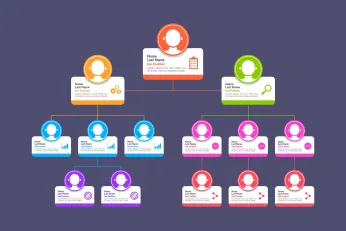في هذه الصفحة
Pay For Performance – a simple act of give and take – may well be the most powerful growth formula in business. But it’s not perfect. Let’s take a look.
Every worker in the world believes they are getting paid less than what they deserve. Every boss in the world believes they are paying more than what is due. No one’s happy but pay for performance – also known as Performance Related Pay - offers a way to make everyone a little happier. It is a compensation model that lifts self-esteem and job satisfaction for workers, while giving bosses what they crave: Greater ROI on their human investments.
Of course, it isn’t always that simple. Research has shown that when it comes to money, employee behavior doesn’t always follow a rational path. Motivation at the workplace is a complex function of several factors like context, perception of justice, social comparison, relationship with boss, image of the self and intrinsic motivational triggers. Yet, that pay has a generally positive effect on performance, is also fairly well documented in research, particularly in the private sector.
What is pay for performance?
Incentive-Pay, or Pay-For-Performance, has historically been considered one of the strongest tools available to leaders and businesses to motivate their workers. A payment against a service, labour or output is a concept easily understood and well accepted in nearly all societies. This is a compensation model that draws a simple path between hard work, proven contribution and measurable achievement on one hand, and monetary recognition on the other. Pay for performance establishes a strong line of sight between action and reward and lays down guidelines for behaviours that are meant to result in increased pay.
Deloitte
Unequal isn’t always unfair
Unequal pay – the essence of any reward mechanism – can be fair. Especially when the reverse might mean telling employees that it is fine to keep delivering mediocre performance and demoralizing top performers with the signal that their merit and efforts will not be recognized or rewarded.
Rooted in research
Empirical studies have shown that pay-for-performance is most effective when work is controllable, repetitive, requires low cognition load, is immune to social comparison and easily attributable. Here’s what some famous theories on the subject say.
Expectancy theory
Expectancy theory indicates a likelihood of increase in motivation and desired performance outcomes when employees…
- Have a clear understanding of pay opportunities that come with the job, along with restrictions and challenges involved, in the context of the organization.
- Are emotionally aligned with both the quantity and meaningfulness of the activity.
- Are confident about successfully meeting expectations.
Goal setting theory
Goal setting theory also stresses on the ‘doable’ aspect. Additionally, it emphasises a level of difficulty that is not too severe, a supportive ecosystem, proper feedback and meaningful increases to pay.
Agency theory
Agency theory tells us that organizations typically have less-than-perfect awareness on the actual levels of skills and efforts of their employees. Leaders therefore close the gap by incentivizing workers with performance based pay. It works.
Workers respond by getting better at skills that help them earn more and also allocate more time on relevant assignments. This helps companies maximize profits by driving superior performance while minimizing counter-product work behaviour.
Kinds of pay per performance plans
Below are the kinds of pay per performance plans-
Eat what you kill: Individual incentive plan
An individual incentive plan lets workers earn financial rewards directly and quickly in exchange of their efforts and contributions towards business goals. This is in contrast to a more permanent and long lasting change in compensation, such as a promotion.
An individual incentive plan encompasses piece rates, commissions plans, discretionary bonuses, non-discretionary and special bonuses, profit sharing, stock options and others. Each is a proven way to delight, motivate and incentivize success behavior across the organizational rank and file. One-off rewards are a common form of the individual incentive plan.
Historically, there is more research data on this kind of individual incentive framework than any other pay for performance model. That’s because in this model, tasks tend to be more directly under the individual’s control, making them feel more doable, and making targets feel more achievable.
The Individual Incentive Plan carries targets and expectations that are unambiguous and well defined, offers relatively larger payouts and is less likely to have performance parameters distorted by peers, teams or group members.
All of this makes the individual incentive plan highly popular with workers across tiers and functions, and a central character in the global narrative on rewards and motivation.
It is also extremely powerful. Most research point to a positive corelation between the individual incentive plan and organizational outcomes. A Cornell study found that while a 1% increase in salary boosted performance by 2%, an equivalent compensation - this time in monetary payment - lifted performance by as much as 20%.
On the flip side, the individual Incentive Plan may cause certain aspects of the role that are not covered under the plan to remain neglected, as in the case study of an international law firm where tasks like strategy and mentoring were being ignored at the altar of billable activities. Focus on nurturing loyalty may get diluted in the wake of efforts prioritizing new acquisition. Perceived inequity through wage comparison may create rift between top performers and laggards as well. It may also be unfair, marginalizing invisible faces behind the scenes who keep the business engines humming but may not be spectacular performers. A model of this kind can jeopardize group dynamics and increase chances of sabotage and attrition in work settings that demand collaborative empathy. Finally, employees may resort to gaming the system in order to achieve more favourable performance figures.
A mature mindset that strikes a balance between recognizing individual and group effort is the path forward in a connected world. Acknowledging team contributions can also help leaders reimagine pay-for-performance beyond the narrow view of a competitive, zero-sum game. Google’s Peer Bonus program allows workers to recognize peer contributions by nominating them for a bonus, stoking innovation and sustainability across the system.
The individual incentive plan most closely resembles motivational conditions set by goal setting theory and expectancy theory. However, it also assumes ideal conditions such as role clarity, workplace transparency and stable economic environments that may not always describe actual work scenarios.
Savor what you kill: Merit pay plans
This is a pay for performance plan that is used primarily for managerial and professional roles of a complex nature typically found in larger and matrixed organizations. In the merit compensation model, a pay increase is done according to the worker’s performance, position and potential, often set against predefined benchmarks. Salary increase, non-discretionary & annual bonuses, project completion bonuses, tiered incentive structures, stock options and profit sharing are some common examples of the merit pay plan.
Merit pay compensation plans prioritize steady contributions and reward sustained performance over the long term, instead of short term achievements.
Unlike in individual incentive plan which is purely results driven, appraisals here are designed around larger organizational objectives. They tend to be holistic and broadly defined, and take into account both qualitative and quantitative aspects of performance. With its well-rounded scope, the merit pay plan addresses nuanced considerations such as self-development, purpose driven projects and greater responsibility which an individual incentive plan is not expected to track.
And while the actual amount of the monetary compensation in the merit pay plan may be smaller than in the individual incentive plan, it is added to base salary (something a commission, for instance, is not) - making it cumulative and permanent in nature; A lucrative, well deserved, long term reward.
Just like the individual incentive plan, the merit pay model isn’t perfect. The flip side features goals and metrices that are less specific and more subjective in nature. This makes them open to interpretation and abuse, potentially causing inaccuracy in attribution and dissatisfaction amongst workers. Smaller payouts can dilute motivation and performance. A hybrid format – combining the motivational advantages of the individual incentive plan with the predictable dependability of the merit pay plan - can plug the gaps.
Share what you kill: Group incentive plans
Group incentive plans - such as gainsharing and profit sharing common in manufacturing and similar settings - are designed to strategically harness aggregate synergies of teamwork towards achieving shared objectives. They are formulated to accommodate the complexity of interdependent and collaborative job roles.
Group plans are usually not tied to base salaries. A well designed group incentive plan will simultaneously offer unambiguous goals, clearly mapped pay to performance linkages and not-insignificant pay packages. Investment banking giant Goldman Sachs is renowned for its generous year-end bonuses, which are linked to the company's overall profitability and an employee’s performance.
Studies credit group incentive plans - specifically where group members are empowered with visibility on company metrices like revenue and profits - with several benefits. Some of them are improved employer-employee relations, enhanced cooperation, greater innovation, deeper appreciation (and commitment to) organizational goals, reduced costs of social comparison, higher acceptance of change and improved productivity.
Not surprisingly, high achieving pay-for-performance organizations are 6X more likely to gather data on overall team performance and considerably less likely than their less achieving counterparts to overemphasize individual performance.
On the flip side, group plans may lack clarity when it comes to isolating and quantifying the productivity of each individual member in the group. Collaborative planning, mature appraisals and delay-proof payouts are some ways that can be fixed.
Hybrid pay plans
To suit their unique needs, resourceful companies innovate hybrid models combining aspects of various pay for performance models. Variable pay plans let high-performing folks earn additional compensation for crossing highly specific milestones (such as fulfilling sales quotas or completing project modules) without compromising on base pay. The additional incentive, however, is usually discretionary and ad-hoc, and not sustained or predictable.
Pros of a pay for performance model
- According to a Gallup study, top performers need their efforts to be valued and recognized and a pay for performance system allows that.
- A pay for performance compensation format not only recognizes ability but also elevates it. Several studies, including one conducted at Oxford, prove that motivated workers are more productive.
- Pay for performance helps retain and attract top talent. As per a Gallup survey, workers who receive high quality recognition are less likely to leave a job.
- Pay for performance enables companies to make more profit flexibly without hurting bottom lines since payment is made after results.
- A pay for performance establishes a culture of proactive improvement and reduced micromanagement.
- Pay for performance strategically aligns workers with organizational purpose and business goals.
Cons of a pay for performance model
- Too much focus on monetary pay may cause other aspects of culture and business to suffer.
- Over prioritization of individual performance may lead to unhealthy competition eroding team culture and cohesion.
- Complex appraisal and rewards systems can make calculations complex, inconsistent and biased, leading to loss of transparency and generating grievance.
- Over reliance on targets and results can lead to stress and burnout.
Average performers may become disengaged when recognition tilts too much in favour of results and numbers. Disillusionment with work may also set in if intrinsic motivations are not addressed.
Pillars of pay per performance
- Participation
- Attribution
- Compensation
How to implement an effective pay for performance system in your organization
A Deloitte opinion states that pay for performance should be a natural by-product of a robust rewards management process, and not the other way around. Here are some steps that can help organizations lay that foundation.
- Pay-for-performance models must be understood and applied in the bigger organizational context to promote the values it stands for.
- Align strengths and abilities with role and reward, ensuring best possible fit.
- Make plans and goals uncomplicated, fair and achievable.
- Involve workers actively in the goal setting process to close alignment gaps.
- Ensure easy tasks that ensure predictable pay do not overly prioritize products with prominent financial hooks and overshadow more challenging assignments that may be critical to the organization in the long run.
- Eliminate conflict of interest between what’s good for the worker and what’s good for the customer, like Morgan Stanley did to remove bias from its customer offerings.
- Plan KPI’s (Key Performance Indicators) and metrices to accurately capture and measure progress.
- Supplement KPI’s with a holistic set of indicators that include aspects like customer satisfaction, innovation and change adaptation. Elon Musk – whose pay package is amongst the grandest executive compensation deals in history - famously needs big targets and milestones to generate feel good dopamine that comes with achieving outcomes many thought impossible
- Build a learning and development driven culture that empowers teams to deliver their best.
- Make regular performance review a non-negotiable element.
- Leverage technology and data to ensure quality in performance appraisals. A Deloitte study shows successful pay-for-performance organizations are 3.4X more likely to track data related to performance.
- Establish transparent, effective and in-moment communication, coaching and feedback mechanisms.
- Bake-in recognition programs that acknowledge achievements quickly, adequately and ‘in public’.
- Keep the model flexible and stretchable to accommodate variations in external and internal environments.
- Create sustainable workflows and templates for long term success.
Research shows high outcome organizations are 1.7 X more likely to employ technology in building agile performance frameworks. Implement one in your business today with Plum.
We offer an intuitive data driven platform for high performance teams to measure achievement, and the world’s largest rewards platform to pay when appreciation is due.













